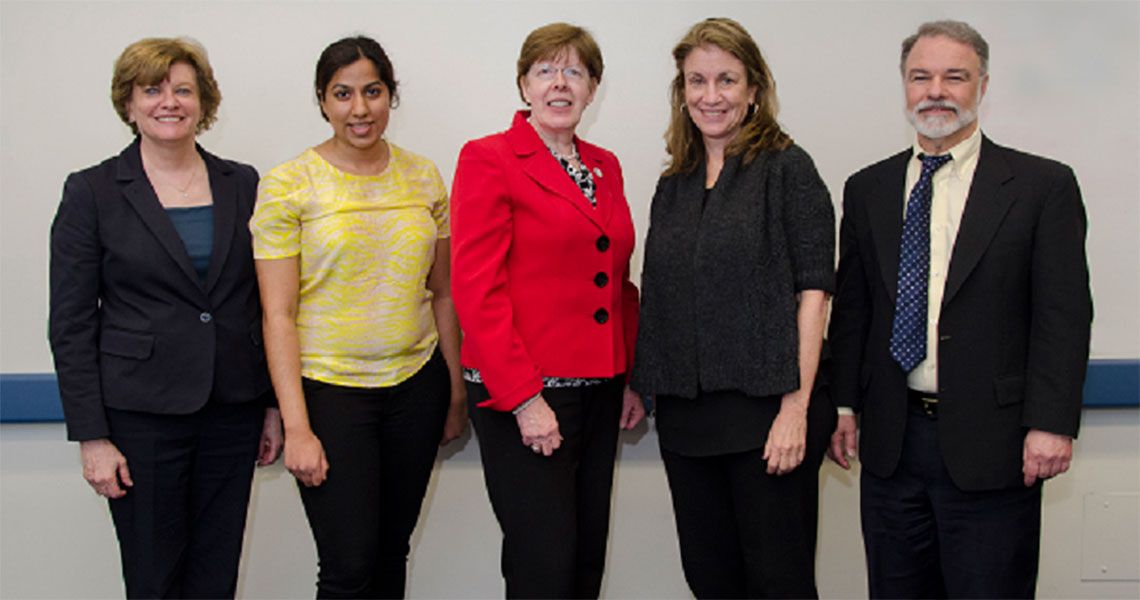“She was my big sister,” Susan Koering said at the presentation of the Sixth Annual Marilyn J. Koering Award on April 20. “When I would come and sit in her classes, she’d say, ‘Now you make sure you take notes, so you look like you’re an academic.’”
Susan smiled at the memory. Marilyn Koering, she explained, her older sister by 13 years, was a devoted professor and researcher at the George Washington University (GW) School of Medicine and Health Sciences (SMHS) for 34 years. “She just loved teaching and working with students who were inquisitive and desired to learn,” she said.
Fittingly, the 2015 award recipient, Kavita Gupta, is a sister herself. Gupta is a triplet, and her brother and sister, Sachin and Lalita, are also first-year medical students at SMHS.
“I’d like to thank my family,” Gupta said after accepting the award. “With a revised curriculum, it’s a lot more of a group effort to learn anatomy.”
Gupta went on to thank her professors, Rhonda Goldberg, M.A., associate dean for student affairs and education, and Vincent Chiappinelli, Ph.D., Loewy Professor of Basic Science, chair of the Department of Pharmacology and Physiology, associate vice president for health affairs, and associate dean of SMHS. Gupta added, “If I met [Dr. Koering], she would’ve been a great mentor, and I probably would’ve been in her office a lot.”
Koering’s specialty was microscopic anatomy, an interest born in adolescence when she worked at the family butcher shop. She went on to earn her master’s degree and Ph.D. at the University of Wisconsin and settled into the GW community in 1969.
According to Kenna Peusner, Ph.D., professor of anatomy and regenerative biology at SMHS, Koering was well known not only for her education and research triumphs, but also for her spirit of survival. Koering was diagnosed with malignant melanoma in 1986 and was one of 30 patients to join an experimental treatment group at Mayo Clinic; she was the last survivor, after battling cancer for 21 years. She fought against the disease, Peusner said, by writing essays, appearing on television, and addressing cancer support groups. She also wrote letters to pharmaceutical companies and the federal government to oblige the companies to provide medication to patients volunteering in experimental treatments. She regularly incorporated her own case history into her anatomy lectures, as well.
“She taught more than 5,000 GW medical students during the course of her career,” said Peusner. “What did her students say about Dr. Koering? They said she was a teacher who cared about them personally and professionally, working to ensure they would excel as physicians.”
Koering made such an impact on the SMHS community that the eponymous award was created in her honor in 2010.
“Excellence in microscopic anatomy was very dear to Marilyn,” added Peusner.
This year, the Marilyn Koering award was given to the first-year medical student with the highest grade in all of the anatomical sciences.
“In the previous five years, the winner was whoever had the highest grade in microscopic anatomy, but because of the transition to the new curriculum, grades were calculated for all anatomical sciences this year,” explained Peusner. “This is the first year that the recipient will have the highest grade in the anatomical sciences up to this point.”
For Susan Koering, the award represents her sister’s success and aspirations.
“The award focuses on people who are dedicated to a focus of their desire and putting everything they have into it,” she said. “Marilyn just loved what she did.”
Susan encouraged the class of first-year medical students to do the same: “Don’t let go of your goal of what you want to be and how you’re going to get there. Just keep that in mind, ‘what’s your pathway going forward?’”



